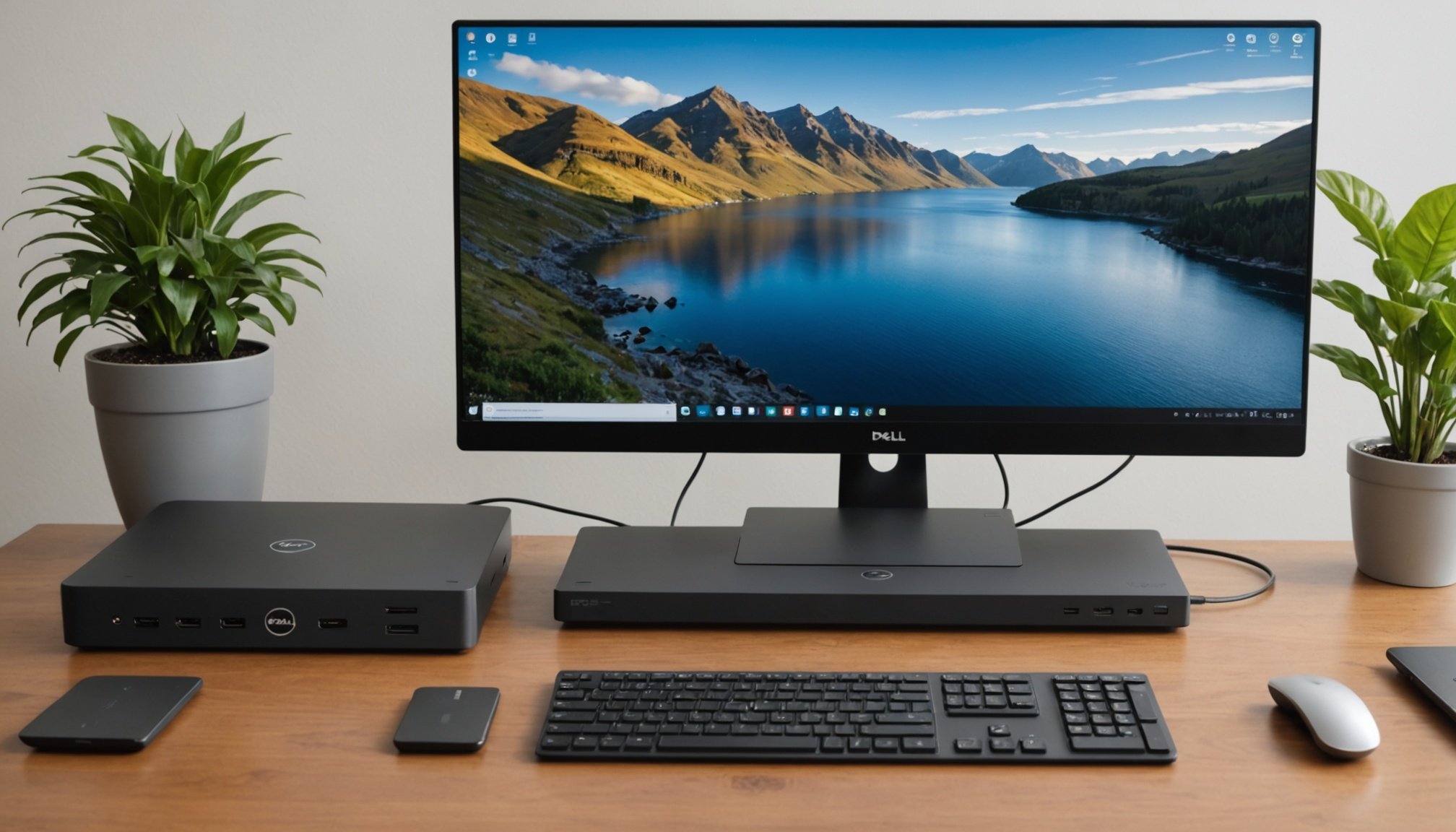Overview of Thunderbolt 3 Docking Technology
Thunderbolt 3 technology is a revolutionary advancement in connectivity, offering remarkable speeds and versatility. Featuring a single cable that combines data transfer, video output, and power delivery, it enhances efficiency and convenience. With speeds up to 40Gbps, it allows rapid data transfer and supports up to two 4K displays or one 5K display.
Key benefits of using a Thunderbolt 3 dock include streamlined workflows and reduced clutter thanks to multiple connectivity options through a single port. This technology integrates seamlessly with devices like the Dell XPS 13, providing expanded functionality and improved user experience. Connecting peripherals such as external displays, storage drives, and other accessories becomes effortless.
Have you seen this : Comprehensive Guide to Boosting Your Lenovo ThinkStation P620 Performance with Additional RAM: A Step-by-Step Setup Manual
Using a Thunderbolt 3 dock with a Dell XPS 13 specifically brings significant advantages. The Dell XPS 13 is known for its sleek design and high performance; pairing it with a Thunderbolt 3 dock maximizes its potential by enabling enhanced connectivity features. Users can experience seamless transitions between workspaces, connect to multiple high-resolution displays, and enjoy efficient charging through the dock. This setup is particularly beneficial for professionals and productivity enthusiasts looking for optimum performance and convenience.
Step-by-Step Setup Guide for Thunderbolt 3 Dock
Setting up a Thunderbolt 3 dock with your Dell XPS 13 can be seamless when following a structured approach. Initially, the process begins with unboxing the dock. Ensure all components are included and undamaged. With the dock removed from its packaging, place it in a location that favors easy access and organization.
Also to see : Unlocking peak performance: key nvme ssd configuration strategies for your asus tuf gaming x570-plus
Next, connect the dock to the Dell XPS 13. Use the Thunderbolt 3 cable included, ensuring a robust connection. This establishes the physical link between your laptop and the dock, unlocking advanced connectivity features straight away.
Once physically connected, it’s vital to address the software aspect. Begin by installing necessary drivers and software. Often, this step involves following on-screen prompts after connecting your Dell XPS 13 to the internet.
Before fully optimizing, check the required updates for the dock’s firmware to ensure compatibility and performance. If the dock’s installation medium provides an installer or setup guide, follow those steps meticulously. Updates may be necessary to enable better communication between connected devices and the dock itself.
Then, consult the manual for further configuration needs. Each setup step enhances your docking experience, providing a superb and flexible workspace.
Configuring Settings for Optimal Performance
To achieve optimal performance, configuring your setup is essential. When using multiple monitors, adjusting the display settings can drastically enhance your workspace. Ensure the resolution and refresh rates are compatible with your monitor specifications for smooth visuals.
USB-C power delivery configuration is another key consideration. Efficient power management ensures your Dell XPS 13 retains battery life while delivering power through connected peripherals. Check power settings to optimise energy usage and maintain device longevity without compromising performance.
For network configuration, setting adjustments can make a significant difference. Prioritise network traffic through Quality of Service (QoS) settings, if available, to ensure an uninterrupted and high-speed connection. This adjustment is particularly valuable when engaging in activities requiring stable internet access, such as video conferencing or large data transfers.
Configuring these settings not only elevates your Thunderbolt 3 dock’s abilities but also aligns with the demands of the Dell XPS 13. By carefully addressing display and power delivery configurations, and optimising network parameters, users can experience enhanced performance tailored to their connectivity needs. This fine-tuning leads to a streamlined, efficient workstation, reflecting both versatility and the advanced capabilities of Thunderbolt 3 technology.
Troubleshooting Common Issues
Navigating through Thunderbolt 3 docking issues can be challenging, but understanding common problems makes it manageable. Connectivity problems often arise, particularly when docks don’t detect connected devices. Ensure all cables are firmly plugged in, and double-check the Thunderbolt 3 port you are using on the Dell XPS 13 supports the intended functionalities.
When dealing with power delivery issues, confirm that the dock is compatible with the power requirements of your devices. Inconsistent charging or power shortages typically indicate a need for higher-capacity cables or docks.
Software challenges may arise, commonly seen in driver conflicts or outdated firmware. Ensure that all drivers are up-to-date. Access support solutions like installing the latest firmware updates, which often resolve persistent connectivity features glitches.
If these steps don’t help, consult your dock’s support documentation or reach out to technical support teams for professional help. Having this fundamental knowledge equips you to pinpoint and solve issues effectively, getting the most out of your Dell XPS 13 and Thunderbolt 3 dock collaboration. Proactive troubleshooting ensures a seamless, efficient user experience, minimizing downtime.
Enhancing Dock Performance
To fully leverage your Thunderbolt 3 dock’s capabilities, embrace a few strategic performance enhancement tips. Start by exploring advanced settings that can maximise its utility. Many docks offer configurable options that improve data throughput and display output, thereby aligning with your workstation needs.
Next, consider investing in recommended accessories like high-quality cables or additional adapters. These not only bolster connectivity features but also increase the efficiency with which your Dell XPS 13 interfaces with other devices. The right accessories enable a smoother, more reliable exchange across peripherals.
Firmware updates often stand as the unsung hero of performance. Regularly updating the dock’s firmware is crucial for unlocking new features and resolving potential bugs. This step can significantly enhance overall performance and introduce compatibility improvements, ensuring your device remains aligned with evolving technology standards.
By tapping into these performance enhancement avenues, users can elevate their Thunderbolt 3 dock experience. Implementing identified tweaks leads to a highly customised setup, promoting a seamless, unified work environment tailored to personal and professional demands. Be proactive and make the most out of each feature to maximise productivity.
Compatibility and Limitations
Understanding the compatibility and potential limitations of Thunderbolt 3 docks is vital for optimising their usage with devices like the Dell XPS 13. These docks boast universal compatibility with a plethora of Thunderbolt 3-enabled devices, lending to a variety of setups.
Compatible Devices
The Thunderbolt 3 dock supports a wide range of devices beyond laptops, such as external graphics cards, high-speed storage solutions, and even docking stations. These features ensure flexibility for users working with diverse tech environments. However, using a Dell XPS 13 offers a refined experience due to its seamless integration with connectivity features provided by the dock.
Limitations with Dell XPS 13
Despite its high compatibility, users may encounter some limitations. For instance, while Thunderbolt 3 allows dual 4K displays, the Dell XPS 13’s specific hardware may restrict some aspects like maximum refresh rates or direct compatibility without additional adapters.
Future-Proofing
To future-proof your setup, consider potential technology advancements in Thunderbolt 4 or USB4, which can enhance docking capabilities further. By keeping up with such tech innovations, users can maintain operational efficiency and extend the longevity of their docking stations, ensuring continued relevance amidst rapid technological changes.
User Experiences and Testimonials
Exploring user experiences and testimonials offers invaluable insights into how Thunderbolt 3 docks enhance daily productivity. Many users commend the seamless integration of Thunderbolt 3 with devices like the Dell XPS 13, specifically praising its connectivity features that turn laptops into flexible workstations.
Feedback often highlights improved efficiency. For instance, users describe setting up multiple peripherals and displays without hassle. The ease of transitioning between workspaces, facilitated by Thunderbolt 3 docks, is consistently noted as a standout benefit, especially for professionals juggling numerous tasks.
Case studies reveal diverse setups tailored to unique professional needs. One user employed a dual-monitor configuration, maximising screen real estate for design projects, while another focused on data-intensive operations, leveraging high-speed storage solutions. These experiences underscore the dock’s versatility, offering custom solutions.
There’s also candid feedback on challenges. Some users share lessons learned, such as ensuring all drivers are routinely updated to avoid connectivity hiccups. Testimonials drive home the importance of staying abreast with software updates and making prudent hardware choices.
Through these collective experiences, the adaptability and robustness of Thunderbolt 3 docks become evident, making them a staple in modern tech-driven environments.
Visual Aids and Resources
Incorporating visual aids in the setup and use of Thunderbolt 3 docks can significantly enhance understanding and efficiency. These resources serve as practical guidance tools, providing users with step-by-step illustrations that simplify complex processes. Diagrams and video tutorials offer precise visual cues, allowing users to efficiently connect devices, configure settings, and troubleshoot common problems without guesswork.
For users of devices like the Dell XPS 13, utilizing additional resources such as setup guides and video walkthroughs is invaluable. These resources often present context-specific advice that can address unique challenges faced when integrating Thunderbolt 3 technology with particular device models. Visual aids help bridge the gap between text-based instructions and hands-on application, ensuring a seamless experience.
While it’s important to select trustworthy sources, certain platforms offer comprehensive resources for further reading on Thunderbolt 3 compatibility. These resources can expand your knowledge and help you make informed decisions about dock configurations and accessory purchases.
By leveraging visual aids and curated resources, setting up and optimizing your Thunderbolt 3 dock becomes less daunting, whether for the Dell XPS 13 or other compatible devices, thus enhancing both user confidence and setup success.











